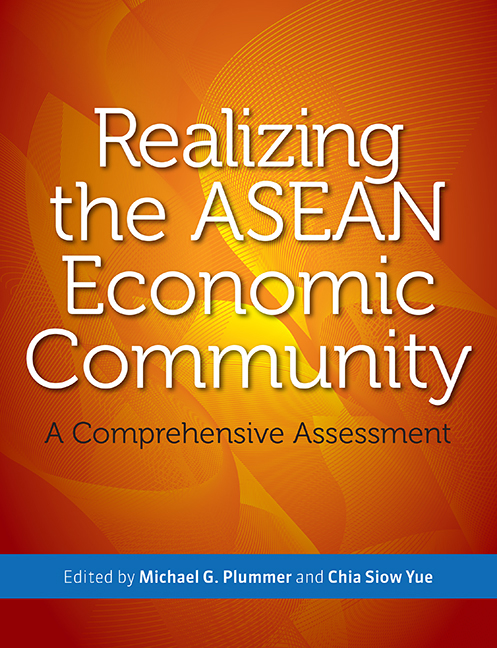Book contents
- Frontmatter
- Contents
- Illustrations
- Foreword
- Executive Summary
- Acknowledgements
- About the Contributors
- 1 Introduction
- 2 Regional Market for Goods, Services, and Skilled Labor
- 3 Competition Policy, Infrastructure, and Intellectual Property Rights
- 4 The AEC and Investment and Capital Flows
- 5 Narrowing the Development Gap in ASEAN
- 6 Competitiveness and Leverage
- 7 Benefits of the AEC
- References
- Appendix A AEC Components
- Appendix B The CGE Model
- Appendix C Developments in Logistics and Aviation
- Appendix D AEC Blueprint Excerpt
- Appendix E ASEAN Free Trade Agreements
- Appendix F ASEAN Member States' Free Trade Agreements
- Appendix G ASEAN Imports and Exports, 2000 and 2006
- Index
6 - Competitiveness and Leverage
Published online by Cambridge University Press: 21 October 2015
- Frontmatter
- Contents
- Illustrations
- Foreword
- Executive Summary
- Acknowledgements
- About the Contributors
- 1 Introduction
- 2 Regional Market for Goods, Services, and Skilled Labor
- 3 Competition Policy, Infrastructure, and Intellectual Property Rights
- 4 The AEC and Investment and Capital Flows
- 5 Narrowing the Development Gap in ASEAN
- 6 Competitiveness and Leverage
- 7 Benefits of the AEC
- References
- Appendix A AEC Components
- Appendix B The CGE Model
- Appendix C Developments in Logistics and Aviation
- Appendix D AEC Blueprint Excerpt
- Appendix E ASEAN Free Trade Agreements
- Appendix F ASEAN Member States' Free Trade Agreements
- Appendix G ASEAN Imports and Exports, 2000 and 2006
- Index
Summary
ASEAN's relations with the world economy are the heart of the fourth section of the AEC Blueprint (Appendix D). Effective integration could turn ASEAN's 10 economies into a global powerhouse — the world's third largest economy, in terms of population, behind China and India — and dramatically improve the region's ability to attract globally mobile capital and technology and develop advantageous partnerships with other economic centers. How can this potential be realized and what benefits would accrue?
The AEC Blueprint envisions an ASEAN distinct from most other regional groupings by its outward focus. This vision reflects economic realities: most ASEAN Member States conduct a majority of their trade with outside partners, have overlapping patterns of comparative advantage, and are embarked on similar, outward-oriented development trajectories (see Chapters 1 and 2). There are real benefits to be had from the internal dimensions of ASEAN integration — e.g., more competition and improved scale economies in production, greater efficiency in consumption — but the benefits of improving the region's competitive position in the world economy could be especially significant.
ASEAN's external success will depend in part on how the region responds to challenges, improves the efficiency of its production system, and manages its trade and investment relations with the rest of the world. These two aspects of integration — improving global competitiveness and using negotiating leverage — are the focal points for this analysis. In the rest of this chapter we explore the challenges posed by a rapidly changing global environment; examine solutions offered by the AEC, specifically strategies for competitiveness and leverage; and assess the benefits that could result from these strategies and how to implement them.
CHALLENGE: ASEAN'S NEW COMPETITIVE ENVIRONMENT
ASEAN has recovered from the financial crisis of 1997–1998 but, at least until recently, its performance has fallen short of its exceptional pre-crisis trajectory. As Figure 6-1 shows, ASEAN's average annual growth rate has declined from 7–8 percent to 5–6 percent and had been reaccelerating gradually before the current economic turmoil began in September 2008.
- Type
- Chapter
- Information
- Realizing the ASEAN Economic CommunityA Comprehensive Assessment, pp. 142 - 163Publisher: ISEAS–Yusof Ishak InstitutePrint publication year: 2009

